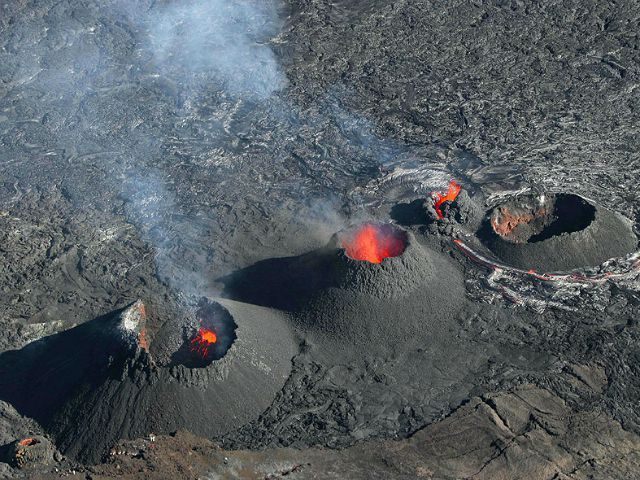One of the world’s most active volcanos is threatening to derail the nascent investigation of debris that may belong to missing Malaysia Airlines Flight 370 on remote Reunion Island. Investigators have been forced to flee as Le Piton de la Fournaise begins to erupt, covering the search area in ash.
Photos of the volcano published in French media Friday morning show lava and ash rapidly rising to the surface. Le Piton de la Fournaise, as well as all the islands that make up Reunion, are French–and thus, European Union–territory. The islands are in the western Indian Ocean, closest to Madagascar.
A La #Réunion, le piton de la Fournaise est entré en éruption http://t.co/aD4YgmpAx1 pic.twitter.com/RRdzih9LqL
— Le Monde (@lemondefr) July 31, 2015
Investigators that landed on La Reunion on Wednesday have been forced to evacuate the island, including ten aviation experts from Malaysia. Before they left, however, they took with them a piece of debris believed to be a piece of a Boeing 777; the piece is currently being flown to France for testing, and due to a number visible on its side, is believed to be a flaperon from that model plane. No other Boeing 777s are known to be missing in the world.
Reports state that it is unclear just how the volcano will affect the investigation, with Australia’s News noting that plumes of volcanic ash will mean planes used to search the ocean will not be able to search the area for some time. Another concern is that Le Piton de la Fournaise is an especially active volcano that has been erupting on and off since February. Even if the current eruption does not last a very long time, the next one could be close behind. La Reunion’s tourist website claims the volcano erupts around every nine months.
The current investigation on La Reunion began on Wednesday, more than 3,000 miles from where MH370 originated: Kuala Lumpur, Malaysia. A beachcomber named Johnny Begue, seeking a pointy rock on a beach at which he works, found what looked like a two-meter-long bit of debris, which he tells New Zealand’s Stuff he identified immediately as plane crash debris. With the aid of some coworkers, Begue hauled the piece of debris now believed to be a flaperon onto the shore, and called a local radio station to tell of the discovery. French investigators were on the scene in hours, and Begue added to his discoveries a piece of what appears to have once been a suitcase.
Malaysian authorities are exercising caution in concluding that the debris is definitely part of MH370, while also showing new optimism towards the discovery. Prime Minister Najib Razak stated it was “very likely” the debris was from, at the very least, a Boeing 777, without going as far as to call it likely a part of this particular plane.
Should investigators prove the debris came from MH370, not all oceanographers will be surprised of its location. Charitha Pattiaratchi, a professor at the University of Australia–the nation leading the search for MH370 in the east Indian Ocean–posited more than a year ago that, in 18 months, the plane’s remains would wash up in La Reunion. She notes at The Independent that MH370 disappeared 17 months ago. Since the location is thousands of miles from the nations relevant to the search and the area where the plane last sent messages back to its airport, few searched so close to Africa, focusing instead on a large expanse of ocean closest to Perth, Australia.
French investigators have stated that, once the flaperon debris arrives in Toulouse, it will be a matter of hours before its origins are identified.

COMMENTS
Please let us know if you're having issues with commenting.